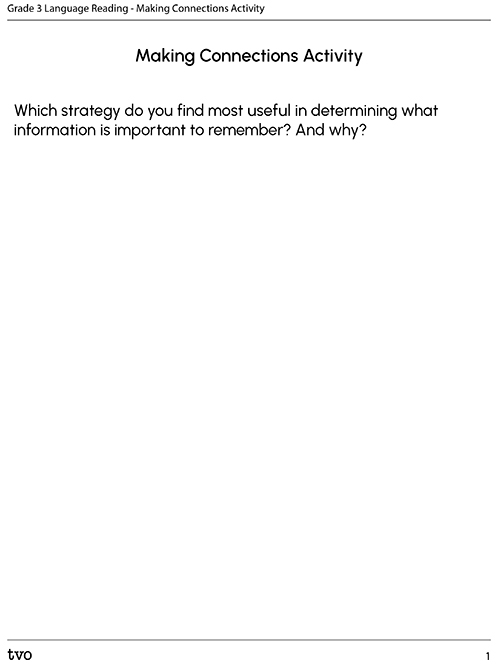Minds On
What is important?
It can be tricky to determine what information is important in nonfiction text. Writers often include additional information on a topic that may be of interest to the readers.

Student Success
Think-Pair-Share
- If a painter is painting a picture, what are some necessary items they may need with them?
- What are some extra items that may not be necessary but would be nice to have?
If possible, share your ideas with a partner.
Note to teachers: See your teacher guide for collaboration tools, ideas and suggestions.
Action
Strategies to determine the most important ideas
Using text features
Nonfiction text often includes different features that highlight the important ideas for the reader. Understanding these features will help you to quickly determine the most important ideas in a text or passage that you are reading. A passage is a chunk of writing that is taken out of a text.
Examine the following chart for examples of common text features:
| Text Features | Definition |
|---|---|
|
Special Font |
Words that are important are often underlined, written in bold, or written all in capital letters |
|
Title |
Tells the reader what the passage/book is about |
|
Subtitle |
Tells the reader what the section will be about |
|
Charts / Diagrams / Graphs / Illustrations |
Helps the reader explain the text using a visual tool |
|
Labels |
Helps the reader locate parts of a picture or illustration |
|
Captions |
Key information written underneath or near a photo or illustration |
|
Maps |
Helps the reader understand information that has to do with location |

Examining the format of paragraphs
How a paragraph is structured can also help you determine the most important ideas in a passage. Understanding how a paragraph is structured can help you determine the main ideas.
Identifying the structure of passages
Nonfiction text is organized in a number of different ways. Identifying the way in which a passage is organized will help you determine the most important ideas. These text structures can include compare/contrast, description, sequence, cause/effect, and problem/solution.
Brainstorm
Structure
- Discuss some common words that could be included in each type of text structure.
- How can we use those words to identify how a passage is organized?
Task 1: Exploring text features!
Explore An Important Black Leader in Nova Scotia, or a nonfiction text of your choice, and identify the following:
- text features
- text structure (e.g., topic sentence and concluding sentence)
- How is the passage organized? What words help you to know this?
The following component is not optimized for a non-visual experience. A transcript is available.
Complete the Exploring Text Features Activity in your notebook or use the following fillable and printable document.
| I found… | From the passage: |
|---|---|
| Text features | |
| Topic sentence | |
| Concluding sentence | |
| How is the passage organized? | |
| What words help you to know this? |
Press the ‘Activity’ button to access Exploring Text Features Activity.
Consolidation
Making connections

Reflecting on our learning helps us to deepen our understanding and use new strategies as we continue to read new texts. After reading The Life Cycle of a Flowering Plant, or a nonfiction text of your choice, use the template provided or a brainstorming/organizational method of your choice to reflect on your learning.
The following component is not optimized for a non-visual experience. A transcript is available.
Complete the Reflection Activity in your notebook or use the following fillable and printable document.
|
Which strategy do you find most useful in determining what information is important to remember? And why? |

Press the Activity button to access the Making Connections Activity.
Activity (Open PDF in a new tab)Reflection
How do you feel about what you have learned in this activity? Which of the next four sentences best matches how you are feeling about your learning? Press the button that is beside this sentence.
I feel...
Now, record your ideas about your feelings using a voice recorder, speech-to-text, or writing tool.